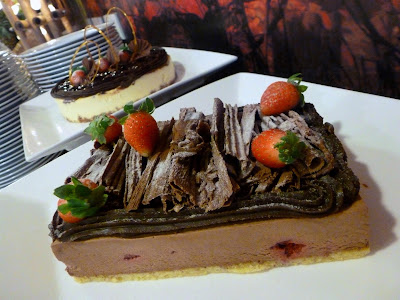Since the launching of Saturday Wild Wild West in the Sun Cafe, I am fortunate to visit to Sunway Hotel Georgetown once again.
Today's event is a preview and launching ceremony of this year's Ramadhan buffet. This event is officiated by Mr. Nagaswaran, General Manager of Sunway Hotel Georgetown.
The Ramadhan buffet is served at the Lower Ground floor of the hotel. This year, Sunway Hotel boasts a whopping 125 dishes including condiments.
For most of the Malay dishes tonight, Chef Azizan is the main chef behind the scenes. Malay cuisine is notable for its liberal use of spices in the form of curry. Fish, chicken, mutton and beef are common meats used by Malay chefs.
Starting with cooked dishes, Kambing Kurma Dan Ubi Kentang (Lamb Korma With Potatoes) features thick, savory gravy made from various spices such as turmeric, cumin and coriander. Its moderate spiciness blends well with the mutton.
Next, Daging Gulai Darat (Kelantanese Beef Curry) is a beef stew rich in coconut milk. Carrots and potatoes are added for balanced flavor.
Moving to poultry, Ayam Percik (Spicy Grilled Chicken) is a dish of oven-roasted chicken coated with spicy gravy made from chili peppers and other spices. In my opinion, the chicken should be cut into smaller pieces to allow the gravy to penetrate deeper into the meat.
As for Ayam Panggang Madu (Honey Grilled Chicken), chicken is marinated with honey, sweet sauce and garlic before roasting. Unfortunately, I think the chicken is overcooked, hence significant amount of meat jus is lost.
Udang Tiga Rasa (Three Flavored Shrimps) features shrimps cooked in a special sauce which contains sweet, sour and spicy flavors. The sauce is nicely prepared, but the shrimps appear to be overcooked too.
Ikan Kari Mat Zan (Chef Azizan's Fish Curry) is Chef Azizan's personal recipe. The curry is starchy in consistency and has an appetizing spicy-sour flavor. Fresh vegetables like okra (lady's fingers), tomatoes and mint leaves are added as counterbalance to the flavorful curry.
Meanwhile, Ikan Goreng Sambal (Fried Fish With Spicy Gravy) uses a special blend of brown sauce with strong, salty taste. I feel that the level of saltiness needs to be toned down for better effect.
One of my favorite meat dishes tonight is Daging Hitam Manis (Beef In Sweet Dark Sauce). Before cooking, beef is first marinated with sweet ketchup, vinegar and oyster sauce. Powdered spices like anise, cumin, coriander and black pepper are also used. The grilled beef is very succulent indeed.
Sotong Masak Kunyit (Turmeric Squid) is one of the two squid dishes tonight. As the name implies, squid slices are braised in an appetizing yellowish gravy made from turmeric.
Meanwhile for Sotong Goreng Cili Kering (Braised Squid With Dried Chili), squid plays a minor role here as there is more potato than squid. Although the squid is still good, I prefer the previous cooking style.
As for shellfish, Kepah Goreng Berempah (Spicy Braised Clams) is provided. Whole clams are braised in gravy of mild spiciness. The amount of meat inside the shells is reasonable.
Moving on to Ikan Masin Nenas Lemak (Salted Fish & Pineapple Curry With Coconut Milk), this curry dish has a mixture of salty and tangy flavors. Coconut milk also serves to provide the desired milky consistency.
Pajeri Terung Dan Nenas (Eggplant & Pineapple Curry) is one of the few cooked vegetable dishes tonight. Soft eggplant (brinjal or aubergine) and ripe pineapple slices absorb curry goodness in a graceful manner.
Kacang Botol Goreng (Stir-Fried Winged Beans) is nicely prepared as the winged beans maintain their crunchy texture. This vegetable dish is flavored with anchovies and chili paste.
The visually appealing Nasi Hujan Panas (Rainbow Rice) uses basmati long-grain rice, which is looser than jasmine rice. To prepare this lovely dish, spices such as kayu manis (cinnamon), bunga lawang (star anise), bunga cengkih (cloves) and buah pelaga (cardamon) are shallow-fried with butter.
Rice is added to the wok and cooked till almost done. Then, each type of dye (red, yellow, orange) is poured on a different location of the rice. Rice is stirred thoroughly, so that grains of different colors mix together. The illusion of rain drops on rice gives rise to the Malay name of this dish.
There are individual warung (stalls) around the dining section, each caters a specific local delicacy. One of the most popular dishes is Kambing Panggang (Grilled Lamb), which is prepared in Cajun style using cayenne pepper, paprika and cumin. Black pepper and mint sauces are provided.
Another crowd favorite is Satay Ayam (Chicken Skewers). Turmeric-marinated chicken is made held in skewers, then grilled over an electric heater. Charcoal is traditionally used for cooking, but a charcoal oven is impractical in an indoor setting.
Satay is best enjoyed with sweet kuah kacang (peanut sauce), cucumber, onion and nasi impit (pressed rice).
Murtabak Ayam (Chicken Murtabak) is a popular Indian-Muslim dish in the Malaysian culinary scene. Minced chicken, beaten eggs and onions are wrapped in flour dough, then cooked with palm oil on a griddle. I personally prefer murtabak to be made fresh as these pre-cooked ones have become soggy and greasy.
Laksa Penang (Penang Laksa) is a Penang's specialty noodle dish. Thick rice noodles are first blanched in hot water. Next, julienned cucumber, pineapple strips, chopped onion, ginger flower and bird's eye chili are added to the noodles.
Then, thick mackerel (ikan kembung) gravy is poured over the noodles. While the gravy is reasonably spicy, I feel that the amount of fish is insufficient. I usually prefer the gravy to be saturated with chunks of mackerel.
Another delicacy of Penang origin is Char Koay Teow (Stir-Fried Flat Noodles). Using garlic, chili paste and soy sauce, flat rice noodles are stir-fried with shrimps, cockles, eggs, bean sprouts and Chinese chives in a hot wok. In my humble opinion, there is room for improvement in bringing out the fiery aroma which defines this dish.
Yet another Penang specialty, Pasembur is a salad mixture of prawn fritters (cucur udang), sausages, fish cake, boiled eggs and boiled potatoes. Sweet peanut sauce is used as dressing.
The Goreng-Goreng (Deep-Fried Fritters) stall features three types of deep-fried delicacies: shrimps, potatoes and bananas. The raw ingredients are coated with a layer of flour batter, then deep-fried in palm oil until they turn golden brown.
My personal favorite is pisang goreng (banana fritters). The fritters should be consumed while still hot from the wok. Otherwise, they become soggy and not so palatable.
Ulam is part and parcel in traditional Malay meals. Uncooked vegetables, such as daun pegaga (Asiatic pennywort leaves), pucuk paku (vegetable fern), daun gajus (cashew leaves), kacang botol (winged beans) and daun selom (selom leaves), are customarily picked by hand and enjoyed with spicy condiments.
Condiments provided for ulam are cincalok (Malaccan fermented shrimp sauce), air asam jawa (tamarind sauce), sambal tomato (chopped tomato sauce) and kicap cili padi (bird's eye chili sauce).
Kerabu, or Malay salad, is also wildly popular in Malay cookbooks. At this buffet, Kerabu Ayam Dan Cendawan (Chicken & Mushroom Salad) is a heavily-seasoned mixture of boiled chicken chunks and button mushrooms. Salted fish is also provided on the side.
Another type of kerabu in tonight's dinner is Kerabu Ulam (Ulam Salad). To prepare this dish, Ulam raja (king's salad), selom leaves, winged beans and other raw vegetables are pounded together in a mortar. Then, the mixture is briefly cooked in a pan without any cooking oil. This dish is served cold.
For health-conscious guests, the salad counter provides a decent variety of fresh vegetables such as frisée leaves, iceberg lettuce, red lettuce and cherry tomato. Mayonnaise and Thousand Island salad dressing are also provided.
As for soup, Chic Kut Teh (Chicken Herbal Soup) is surprisingly flavorful. This Chinese-inspired broth is flavored using chicken bones and traditional Chinese herbs and spices like star anise, cloves, cinnamon, wolfberries and dates.
There is also a handful of delectable Malay kuih in tonight's buffet. Cucur Badak is made from sweet potato and is filled with spicy ground shrimps and grated coconut kernel. Puteri Ayu is a pandan-flavored pastry which is steamed in a cupcake-like mold. Onde-Onde is deep-fried pastry filled with sweet mung bean paste. Kuih Jagung is quite sticky in texture and is made from sweet corn. Last but not least, kurma (pitted dates) is usually the first food to be eaten when Muslims break fast in the evening.
Moving to the dessert section, the Chocolate Cake is a punctuated with almond flakes and topped with walnuts, prunes, peaches, strawberries and kiwi.
The Pecan Pie is filled with various mixed nuts include pecan nuts and cashew nuts. Honey is added to hold the nuts in place within the pie crust.
The Chocolate Mousse Cake is topped with chocolate cream and chocolate shavings. Blueberry Cheesecake is also available.
For smaller portions of desserts, try the Pulut Mangga (Glutinous Rice With Mango). This Thai-inspired dessert is made from glutinous rice soaked with sweetened coconut milk. Diced mango is added for extra sweetness.
Pulut Inti (Glutinous Rice With Sweet Coconut) is another bite-sized dessert with sweetened coconut toppings. This sweet treat is typically wrapped in banana leaves to prevent the toppings from drying.
To cater your sugar tooth, there are also individual portion of fruity pudding and jelly to choose from.
Finally, the fruits platter contains mostly local fruits, such as pineapple, strawberry, honeydew, papaya, watermelon and banana.
Sunway Hotel's Ramadhan buffet is served from 20 June 2015 to 14 July 2015. The net prices are RM52.00 per adult and RM32.00 per child between 6 and 12 years old. There are also lucky draw prizes to be won during the month-long campaign.
Meanwhile, Sunway Hotel Seberang Jaya is also hosting its own Ramadan buffet. I heard that the menu there is entirely different from its counterpart in George Town.
Address: 33, Lorong Baru, 10400 George Town, Pulau Pinang
Contact: 04-229-9988
Business hours: 6:30pm-9:30pm
Website: http://georgetown.sunwayhotels.com
Coordinates: 5.41426 N, 100.32568 E
Directions: Sunway Hotel Georgetown is located at New Lane (Lorong Baru). It is accessible from either Macalister Road (Jalan Macalister) or Jalan Dato Keramat, but the former entrance is usually congested by hawker stalls. The hotel provides parking for its diners at RM3.50 per entry.













































No comments:
Post a Comment